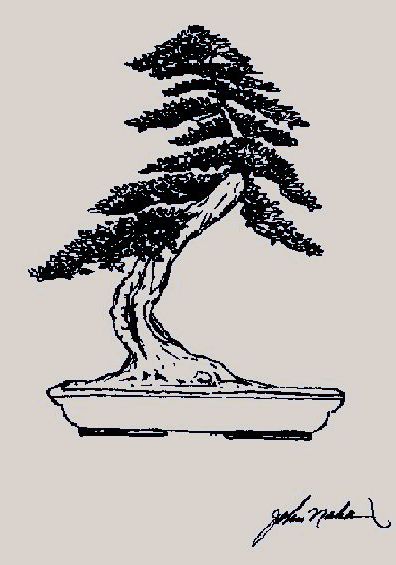
Phoenix Bonsai Society Club Logo rendered in 1993 by John from a tree that had been designed by their teacher Leroy Fujii, |
IN CELEBRATION OF A GRAND MASTER'S LIFE
PART IV
This Page Last Updated: February 4, 2018
|
The 2nd World Bonsai Convention of the World Bonsai Friendship Federation
(WBFF), "New Horizons," was held in Orlando, FL from May 27 to 31, 1993.
This was in conjunction with the BCI and ABS conventions. Saburō Katō,
Yuji Yoshimura, and John were the headliners for the over seven hundred delegates who attended.
|

Phoenix Bonsai Society Club Logo rendered in 1993 by John from a tree that had been designed by their teacher Leroy Fujii, |
|
From November 3 to 6, 1994 a joint BCI/GSBF convention took place in San
Jose, CA. Guests of honor were John Naka, Toshio Saburomaru, and
Yuji Yoshimura. Enthusiasts attending from outside this country hailed
from Canada, Mexico, Guatemala, Puerto Rico, Brazil, the Netherlands, Italy,
Australia, and Japan. The GSBF was seeking to establish permanent
masterpiece bonsai collections in two different areas of the state.
The Huntington Library and Gardens would have Collection-South.
34
On March 25, 1995 John donated an olive bonsai to the Golden State Bonsai Federation Collection at the
Huntington Botanic Garden. This was the olive he had collected on July 4, 1958.
From Aug. 30 through Sept. 3, 1996 John was the headliner for the Bonsai Societies of Florida 24th annual state convention held in Fort Lauderdale. This convention was one of the most successful for the state in many years. Having John was the highlight for the more than 250 attendees who came from all over the U.S., the Carribbean and South America. Nine other artists and teachers were there, also, but it was the appearance of Naka-san that drew these people from so far away. John performed a master workshop for ten of the lucky attendees who were fortunate enough and fast enough to sign up and take advantage of his expertise. He did a special ten tree critique of the exhibit, as well as generously spending a multitude of hours signing his books. 35
March 20-24, 1997 was the 40th Anniversary Show of the California Bonsai
Society. It featured a two part "retirement" demonstration
by John Naka, ably assisted by the likes of Ben Oki, Mel Ikeda,
Ernie Kuo, and similar star pupils of the grand master.
Roy Nagatoshi was the emcee. Spry and entertaining at age 82, Naka-san
could still deftly wield a medium-sized chain saw to sculpt a large California
juniper, requesting various tools from his senior students in Japanese.
|
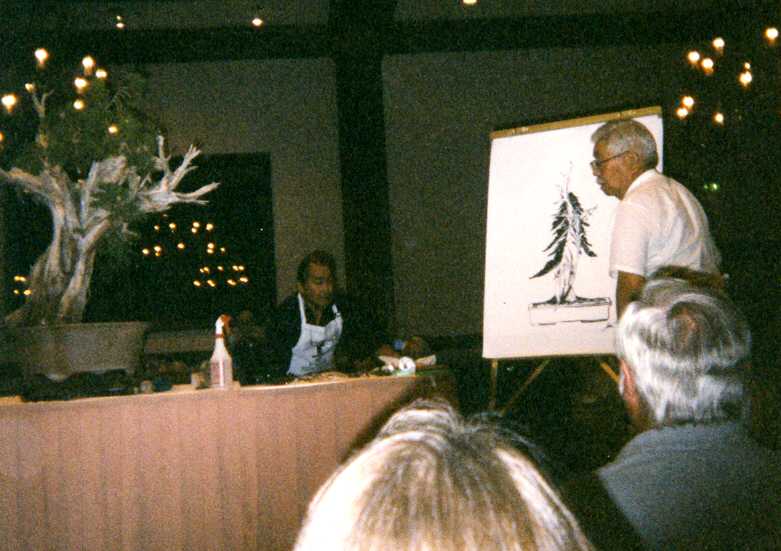
Mel Ikeda and John Naka.
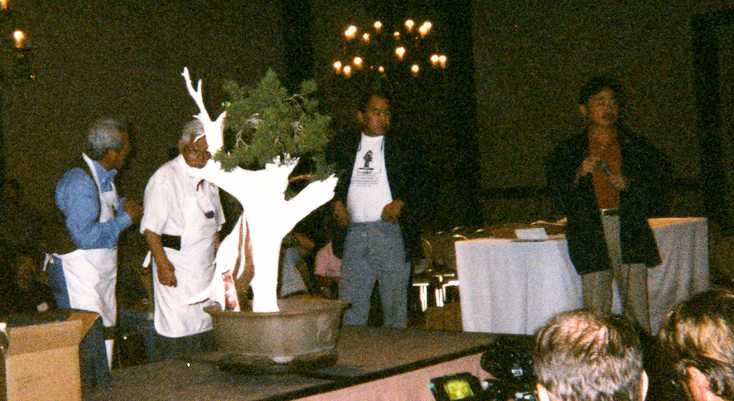
|
Notable bits of Naka-san's philosophy heard there include:
"Bonsai is not the result: that comes after. Your enjoyment is what is important."
This convention also included fifteen workshops, benefit drawings, vendors,
banquet, and the Exhibition of Bonsai: Treasures of the Heart at the Huntington
Botanical Gardens. Here, the permanent Collection-South was officially
inaugurated with a few dozen of the local artists' best compositions, some
truly magnificent examples of this hobby. Most if not all of these
specimens owe some of their shaping to John's teachings.
|
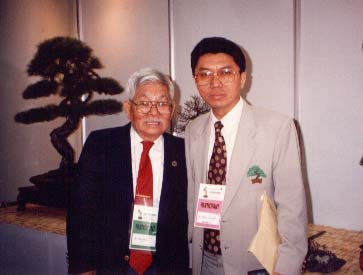
John Naka and Budi Sulistyo, 10/97. (Photo courtesy of Alan Walker, 05/11/07) |
|
John was in Seoul, Korea as part of the 3rd World Bonsai Convention of
the WBFF (Oct. 24 - 28). This was the last WBC in which John attended/participated.
From June 12 - 17, John was the guest of honor in Pisa, Italy
of the European Bonsai and Suiseki Convention 1998. This year Marc Noelanders'
Bonsai Art book was published with a Foreword penned by John.
|
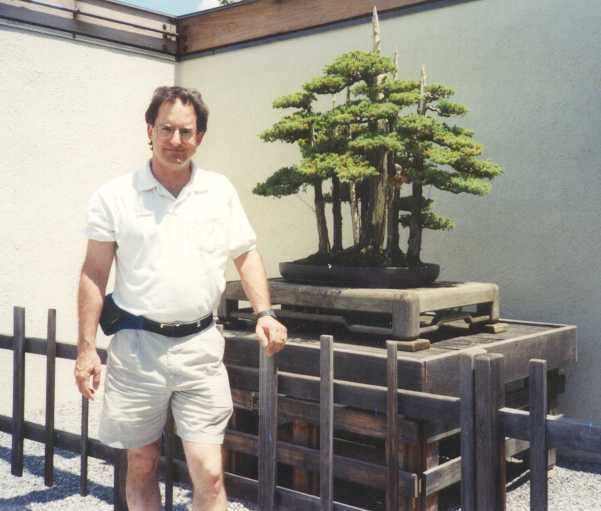
|
In April, 1999 John went to the National Arboretum for three days to direct
work done on Goshin. He worked on a number of other trees as well.
A few years earlier John slightly shifted his creative gears. When he was a young adult he had been painting in oils and styling bonsai. As the latter came to the forefront, he realized he could not properly dedicate himself to both disciplines. He had painted numerous landscapes, a self-portrait, and a portrait of Alice Naka while he designed bonsai. He believed he could be successful by pursuing only one art. He chose to become a bonsai master and was the first to travel the world sharing his love of bonsai. John put away his paints and continued that form of expression through his sketches made prior to designing dwarfed trees. For decades, John didn't pick up a brush, but late in life he renewed his love of painting and began taking art classes to resume his acquaintance with oil painting. He wanted to stop teaching bonsai in the 1990s to concentrate on painting, but his students (including Cheryl Manning) wouldn't hear of it. He slowed down, teaching half-day instead of all-day, and only 6 times a year instead of 12. His garage became his art studio where he focused on landscapes, details of nature, and numerous views of koi, spending several hours a day on this passion. In his golden but still very active years, the master kept his collection of bonsai in show shape. The energy with which he shared his knowledge of bonsai was now directed into soaking up all of the information his teachers had to offer. The master became the student. John was right-handed, but a chronically sore wrist had affected how much time he could spend painting. Using his left hand, he recently completed a painting of poppies. The result was every bit as lovely as his right-handed work. Nothing would stop him from doing what he loved. Lamenting and exaggerating his decline -- "I can't see, I can't hear, my wrist hurts," etc. -- he did acknowledge that his mouth was in perfect working order, so his ability to express himself and enlighten others with the flair of an entertainer had not been affected with the passage of time. |
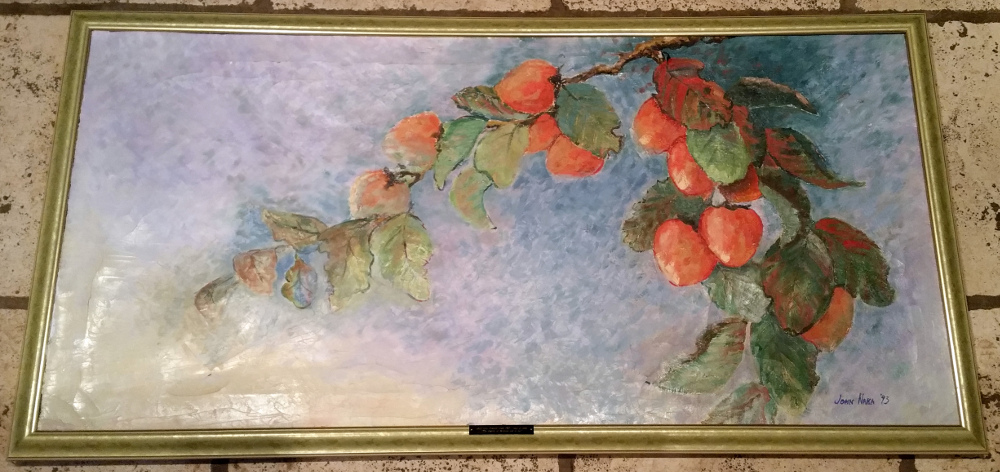
Persimmon Oil Painting from 1993, 20 x 40" (51 x 102 cm). |
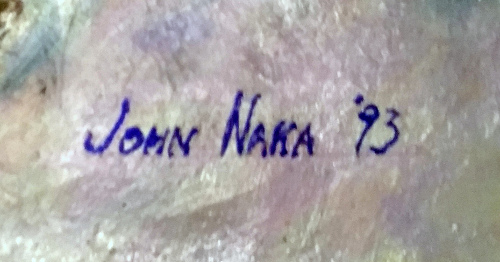
John's signature |
|
The California juniper from Sand Canyon, with its classic oblique twisted half
dead wood, half live wood form, and which was an example of John's artistry that
helped him win the Arts Heritage Fellowship in 1992, would be found near the
entrance to the Lakeside Park Bonsai Garden near downtown Oakland
when the Golden State Bonsai Collection-North opened there on Nov. 6, 1999.
A week later, during the GSBF convention (Nov. 11-14) in Anaheim, CA, John made a guest appearance for both a ten-tree workshop and a demonstration in which he created what is being called Goshin Two. This time he did not do a sketch prior to the demonstration so that he wouldn't be locked into a design. He would rather have a healthy forest planting than a dead copy of Goshin. In addition to his Nanpukai students, John was joined by his grandson, Mike Naka, who has studied bonsai with his grandfather for several years. 37
A Warren Hill color photograph of Goshin graced the Fall 2000 cover of the ABS Journal.
Of note are the fine guy wires rising from places along the
outer edge of the soil up to some of the outer branches of the composition.
|
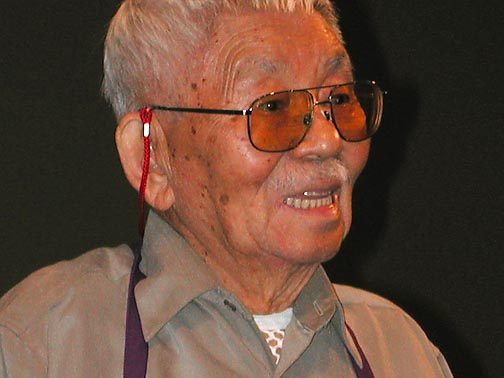
John Naka, 03/22/02. |
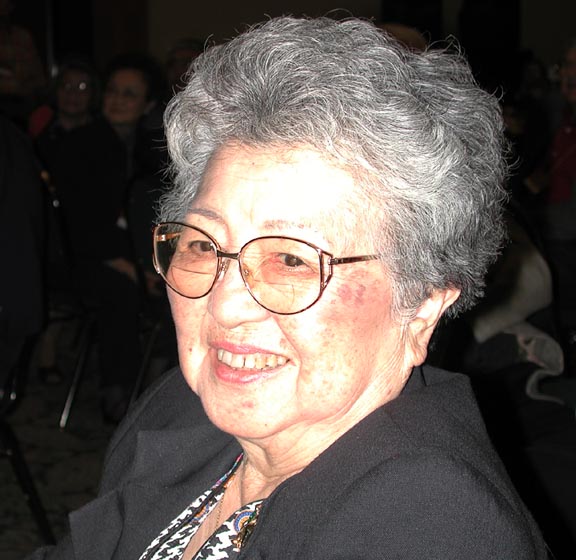
Alice Naka, 03/22/02. |
|
John was honored at the Forty Fifth Anniversary Exhibition and Convention
of the California Bonsai Society, March 21 through 24, 2002. Per John's insistence, this month a
new election of NABF officers resulted in John being elected "President Emeritus" of the North
American group and Felix Laughlin as the new President of the group. In turn, the WBFF Board
then approved the appointment of Saburō Katō and John Naka as "Chairman Emeritus" and
"Vice-Chairman Emeritus" of WBFF, respectively.
In mid-May, John attended the dedication of the Katō Stroll Garden which was added to the Bonsai and Penjing Museum at the National Arboretum in Washington, D.C. Old friends that Saburō Katō and John Naka were, the two grandmasters of the art met one last time. And while John privately complained of arthritis in his knees, his masterpiece Goshin was looking in very good health. 38 |
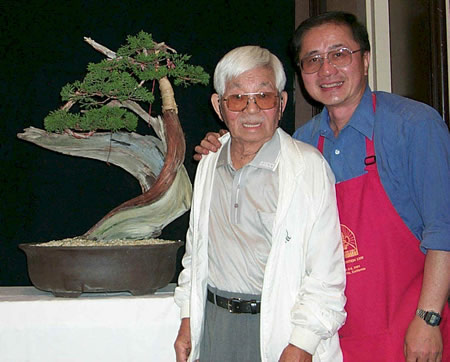
John Naka and Ernie Kuo, 11/11/02. (Photo courtesy of Alan Walker, 05/11/07) |
|
The premier issue of the North American Bonsai Federation Newsletter was released
online on November 8. As a tribute to his longtime efforts, the
NABF Newsletter #1
was primarily dedicated to John Naka. Best wishes and personal insights from friends and admirers
in North America and around the world were presented. Pictures of many of the key players during
this sensei's first 88 years are therein presented.
A photo of John, with a massive shari'd juniper during a recent workshop at his home, graced the
cover of the September/October 2003 issue of BCI's Bonsai magazine. The accompanying story
(pp. 20-22) has twelve photos by May McNey, Patrick Heath, and Peter Bloomer taken
from the late 1970s through August 2003, John's 89th birthday.
On May 19, 2004, Grandmaster John Yoshio Naka died at Whittier Hospital
Medical Center at 11:35 a.m. He had been hospitalized with complications from shingles which apparently
compromised his system and caused respiratory and renal failure, three months short of his 90th
birthday. His legacy shall live on. A French site quickly put up a cartoon of
Goshin with the translated caption: "John Naka has gone. A whisper
of astonishment wanders in between the branches of Goshin."
39
"Universally acknowledged as the most famous and most
popular bonsai artist in history, Naka-san touched the lives of every one of us, whether we met him or
not. John Naka was the sort of person who connected well with people, whether they were the
leaders or the first time visitor. John had a charismatic penchant for seeming to remember
everyone’s name. And he would remember details of the trees you had in workshops that even
you probably didn't recall. John is remembered by many for his awesome bonsai talent and
knowledge, but he had tremendous political skills, too. He had a rather unique ability to
tolerate any level of skill while striving for perfection. A great leader and a great friend,
John is the stuff of legend."
"His enthusiasm for life and for bonsai was boundless, and his sense of humor was never more spontaneous
than when he told a story for the hundredth time and burst out laughing every time. He was generous
of spirit and with his time, and he had no patience for pettiness or pessimism. Chief among his
attributes was humility; he never referred to himself as a 'master,' but as a 'student.' He
considered the trees to be the teachers."
A tribute article consisting of 32 reminiscences, 1 color
and 10 b&w photos was published in pp. 6-10 of the July/August/September issue of BCI's
Bonsai magazine. The cover of issue No. 93 of Bonsai Today had a picture of
Goshin on it and there were photos of a couple of John's other trees inside.
Back to Top
|